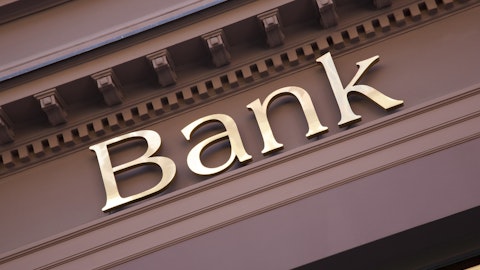Banco Latinoamericano de Comercio Exterior, S. A. (NYSE:BLX) Q4 2023 Earnings Call Transcript February 23, 2024
Banco Latinoamericano de Comercio Exterior, S. A. isn’t one of the 30 most popular stocks among hedge funds at the end of the third quarter (see the details here).
Operator: Good morning, ladies and gentlemen and welcome to Bladex’s Fourth Quarter 2023 Earnings Conference Call. A slide presentation is accompanying today’s webcast and is also available on the Investors section of the company’s website at www.bladex.com. There will be an opportunity for you to ask questions at the end of today’s presentation. Please note, today’s conference call is being recorded. As a reminder, all participants will be in listen-only mode. I would now like to turn the call over to Mr. Jorge Salas, CEO. Sir, please go ahead.
Jorge Salas: Good morning, and thank you everyone for joining us today to discuss our 2023 fourth quarter results. I am thrilled to share today, not only the highlights of an exceptional quarter, but also the milestones of a truly all around record breaking year for Bladex. I will begin with a review of our achievements in 2023, before handing it over to Annie, our CFO who will share the details of our quarterly results. Afterwards, I will also share some insights into our outlook for 2024 including an update of our dividend policy and guidance for the year. 2023 was extraordinary for Bladex. Simply put, no matter which KPI you look at, last year was, without any doubt, the best in our bank’s history. After two years into the execution of a five year strategic plan, Bladex is a different bank.
While Bladex remained decidedly committed to its DNA as the trade bank for LatAm with a business model that is intrinsically low risk, our bank is now consistently following its strategic plan aimed at achieving sustainable mid-teen returns. Our plan is seeded in the minds of a renewed management, rewarded through a recently redesigned variable compensation program that is clearly aligned with long term objectives of our shareholders. Let’s take a quick overview of our year. Our credit book grew 9% year-on-year and 3% just last quarter. Moreover, the commercial portfolio is up 30% since we began executing the plan a couple of years ago. Today, our $9.5 billion credit portfolio is not only at record high, but more importantly, it is as diversified and as healthy as it has ever been, with NPLs close to zero.
Deposits, on the other hand, rose 38% year-on-year to over $4 billion for the first time ever in our bank’s history. This not only further reinforces our robust funding structure, but also reflects the ample upside of cross selling to our existing clients as well as the confidence that a wide number of investors from different geographies place on us. After an already strong 2022, 2023 was also very remarkable in terms of new client on boarded, as well as accelerating the cross sell of other products, such as letters of credit, deposits, and syndications. On the profitability front, I’m happy to report that net interest income amounted to $233 million, which represent a 58% increase year-over-year. Furthermore, our net interest margin also reached an all-time high of 2.5%, a 78 basis point improvement from the previous year.
Additionally, our focus on fee income also yielded remarkable results, with an increase of 64% from 2022 reaching a record level of $32.5 million. This resulted in net income soaring 81% to a historic record of $166 million for the year. Annie will share details on all this soon. Let’s move to Slide 2 please. A couple of things here. First, after two years in our journey, you can see that we are at a pivotal juncture, transitioning from the optimization phase to the expansion phase of our strategic plan. Second, today, we are within the higher end of the range of profitability targets for 2026. Main goals during the optimization phase has been successfully achieved. Our use of capital today is more efficient, and we have streamlined key processes to ensure faster client onboarding and enhanced operational capabilities.
The effective completion of this first phase has allowed us to both significantly grow our customer base in strategic markets and also increase lending margins through an efficient pricing policy on a larger client base. The expansion phase on the other hand, will focus on broadening our product offering. As we have continually stated, we are convinced that there is significant upside potential in three main areas. One, complementing our bilateral short term, plain vanilla, trade lending with buy and sell side working capital solutions for our corporate clients. Second, there’s also substantial upside in incorporating treasury products to better serve our clients needs. And finally, there is additional upside potential in opportunistically engaging in selected project and acquisition finance deals.
Last year, we started making progress in all three fronts. For instance, we are already in the initial phase of our vendor selection process for our treasury software. We anticipate that for the next couple of years, Bladex will be closely working with IT vendors in order to make sure that the bank’s product suite expansion has a robust and scalable back end. Also, on the accounts receivable discount front, for example, our recent partnership with Greenbridge Capital in Chile is particularly exciting. This alliance will allow us to launch a domestically A rated private credit vehicle that will enable us to penetrate the Chilean factoring market with healthy margins and robust credit quality, as the discounted receivables come from top local corporates.
Furthermore, this alliance also holds a promising potential for scaling into new markets in the region. On the project finance side, our newly established project finance and infrastructure team had an outstanding first year having already executed eight new transactions and increasing top line revenue by six fold versus 2022. Our accomplishments included the co-leadership of a $395 million deal in the Dominican Republic for a key multinational client in the renewable energy sector. This new project finance portfolio is already well-diversified, covering sectors like renewable energy, oil and gas, digital infrastructure, roads, ports, and logistics. As we have explained before, the rationale behind this opportunistic initiative is two-fold.
First, to the extent that project finance transactions tend to be for longer tenure than the typical trade finance deals, they provide additional stability to our loan portfolio. And secondly, these types of transactions will keep enhancing profitability through better spread and substantial structure and fees. I’m going to leave it here for now and turn the call to Annie, our CFO who will walk you through the results in detail. Annie.
Ana de Mendez : Thank you, Jorge, and good morning to everyone. I am now happy to give you more color on these outstanding results for our bank, both for the fourth quarter and full year 2023, in which we achieved historical records in several financial metrics, as Jorge mentioned. So let’s please move to Slide 4. Net income reached record levels, totaling over $46 million for the fourth quarter and $166 million for the full year 2023, representing annual increases of 50% and of 81%, respectively. Quarterly net income has increased consistently over the last two years as a result of strong business volumes, higher margins and fees, resulting from the successful execution of our strategic plan and a favorable market environment denoted by higher interest rates and sound economic and trade growth across markets in Latin America.
This record recurrent operating results drove an annualized return on equity of 15.5% for the fourth quarter and of 14.7% for the year, the latter representing an annual increase of close to 6 percentage points. Let me now walk you through our balance sheet and profit and loss statements, underlining the main items driving this exceptional performance. So moving on to Slide 5. Total assets amounted to $10.7 billion at year-end, an increase of 16% from 2022 on the back of a robust loan portfolio balance complemented by a stable portfolio of investment securities and a sound liquidity position. The bank’s cash position, mostly placed with the Federal Reserve Bank of New York, led to liquidity levels of 19% of total assets and 45% of deposits at year-end.
These ratios reflect our prudent liquidity management approach, given the wholesale nature of our business model. It’s worth mentioning that Bladex follows Basel methodologies, liquidity coverage ratio as required by Panama’s banking regulator. The commercial portfolio, including loans and off-balance sheet letters of credits and guarantees once again achieved record levels, reaching $8.5 billion at year-end, up 11% from 2022. In the next slide, the commercial portfolio, which constitutes the bank’s core business continues to be short term in nature, with an average remaining tenor of 13 months. At year-end, 69% of the portfolio was scheduled to mature in the next 12 months. This portfolio is well diversified across countries and industries in the Latin America and Caribbean region, with top exposures in Brazil at 13%, Colombia at 12% and Mexico at 11%, complemented by relevant exposures in other Central and South American countries.
Throughout the year 2023, new client onboarding and product cross-selling continue to drive strong business volumes, particularly in the letter of credit business and vendor finance, both closely related to short-term commodity trade financing. Bladex also maintains a $1 billion investment securities portfolio, providing further country risk diversification and mostly consisting of eligible assets to be discounted at the Fed discount window through our New York agency. At year-end, 73% of this portfolio was placed with non-LatAm issuers, mostly from the U.S. and 99% was comprised of securities held to maturity accounted for at amortized cost, with the remaining 1% accounted for at fair value through OCI with a market value close to par at 100%.

Overall, 81% of the investment portfolio is placed with investment-grade issuers. The average remaining tenor of the portfolio is less than 2.5 years. On Slide 7, funding sources remain well diversified across products, geographies and tenors. Deposits representing 49% of total funding at year-end set a new record, surpassing $4.4 billion, up by 38% year-over-year. This significant growth reflects the combined effect of our cross-selling strategy and the success of our Yankee CD program, which provides granularity to our funding base, together with the continued relevant participation of our Central Bank Class A shareholders. These deposits are overall short-term in nature with a combined average original maturity of more than four months at year-end, representing a cost-effective, recurrent and stable funding source.
As of year-end, short-term borrowings and debt represented 19% of the bank’s funding base. This consists of both facilities from correspondent banks and issuances in the public and private format with tenors of up to one year. Bladex maintains an ample base of correspondent banks worldwide. Bladex also complements its robust deposit base with long-term borrowings and debt representing 29% of the bank’s total funding at year-end. The bank has currently outstanding public bonds in the U.S., Mexican and Panamanian debt capital markets as well as public placements under our EMTN program in multiple geographies. Bladex also has a fluent access to the international loan market through both syndicated and bilateral facilities. Our equity position continues to be enhanced by earnings generation and reflects the bank’s internal risk appetite.
We aim to maintain our capital ratios at current levels, even as we continue to grow our business and our balance sheet. Now turning to Slide 8. Over the last several quarters, Net Interest Spread or NIS, the assets and liabilities average rate differential has shown an increase in trend, reaching 1.92% for the fourth quarter and 1.84% for the full year, up by 45 basis points from 2022. Higher lending spreads, efficient cost of funds given a higher deposit base and a proactive management of the short-term interest rate gap in an increasing rate environment stand as the main drivers of this positive NIS trend. So moving to the next slide. This NIS growth, along with higher average volumes have boosted net interest income, or NII, being responsible for 61% of NII annual growth and reflecting successful strategy execution, particularly with regards to new client onboarding, cross-selling efforts, which include higher deposits from our client base and a strict emphasis on pricing, profitability and capital optimization at a transaction level.
In turn, higher market interest rates have also had a positive impact on our net interest income, accounting for 39% of NII growth during the year. Given the short tenor of our balance sheet, both assets and liabilities have mostly fully repriced at higher market rates. Overall, average asset base rates for 2023 have increased by over 300 basis points compared to the prior year, generating increased revenues from the share of assets funded by our equity. Overall, net interest income for the year totaling $233 million increased by $85 million or 58% year-over-year. Reaching an annual net interest margin of 2.49%, up by 78 basis points from 2022, driving strong top line performance as it represents close to 90% of total revenues. Moving on to Slide 10.
Fee income has also shown a strong performance throughout 2023, having increased 64% year-over-year, driven primarily by higher activity on the letter of credit and loan syndication lines of business, both pillars of our business plan. This is also a reflection of the bank’s focus on enhancing cross-selling ratios across our customer base. In the specific case of long syndications during the fourth quarter, we structured two new transactions, driving the reported $3.5 million in fees for the quarter. As shown on Slide 11, most of the credit portfolio that is 96% is classified as low risk or Stage 1 as defined by IFRS 9, while another 4% is classified as Stage 2, representing credits with increased risk since origination and which are all performing.
Overall, credit provision charges for the fourth quarter were close to $10 million, mostly reflecting the increased balance in Stage 2 exposure to $369 million. On the other hand, only a minimal 0.1% of total exposure remains classified as impaired credits or NPLs, amounting to $10 million, with a total reserve coverage of over 6.5 times. On Slide 12, strong revenue growth continues to have a positive impact on the bank’s efficiency level, allowing the cost-to-income ratio to remain at around 27% throughout all four quarters of ’23. During the fourth quarter, expenses increased by 10% from the preceding quarter, mostly due to the ramp-up of projects related to strategy execution. Expenses for the whole year 2023 increased by 32%, mostly due to a higher salary base from new hires as our workforce increased by close to 50% over the last two years, congruent with our focus on strengthening Bladex’s execution capabilities as outlined in our strategic plan.
In addition, in 2023, there was an increase in performance-based variable compensation directly related to the bank’s strong results. With this, I would like to turn the call back to Jorge. Thank you.
Jorge Salas: Thank you very much, Annie. Let me just make a couple of comments on our macro view and discuss a few things about capital management. In 2023, the threat of a global recession diminished as the year evolved. Initial growth forecast for the year were frequently revised upwards as the year progressed, leading towards a soft landing scenario. Despite ongoing geopolitical conflicts, the global economy was resilient and grew 3.1%. For 2024, expectations for growth are similar, although there are potential downside risks from geopolitical tensions and key elections in various regions of the world, including Latin America. Crucial for Bladex is the fact that global trade is also expected to rebound significantly in 2024 with a 3.2% growth after a stagnant 2023.
Even though it’s not our base case scenario, a potential slowdown in China’s economy will affect commodity prices and therefore, trade mostly with the southern countries in Latin America. In any case, Latin America grew 2.5% in 2023, slightly below the global growth rate. Central banks in the region largely adopted restrictive monetary policies to combat inflation, which impacted both consumption and investment. This year 2024, growth in Latin America is projected at 1.9% according to the IMF. We expect that for the most part, domestic interest rates to remain high due to ongoing inflationary pressures, even though central banks are Class A shareholders like the Central Bank of Brazil, Chile and Peru have started to reduce them. We see countries like the Dominican Republic, Guatemala, Uruguay, Paraguay and Costa Rica are well positioned to navigate 2024 due to strong economic fundamentals and sound policy responses.
Meanwhile, Brazil and Mexico, we joined the account for 45% of the region’s GDP remain key markets for Bladex with significant business opportunities. We’re also active in Chile, Peru and Colombia, even though all of them face their own set of political and economic challenges. On the other hand, Argentina, Bolivia, Ecuador and El Salvador faced even more considerable challenges as they undergo significant policy adjustments. In this scenario, we anticipate that our commercial portfolio will grow between 5% and 7% and deposits at double that rate, thereby gaining a larger share in our funding mix. But while balance sheet growth remains important, our priority for 2024 will be to preserve the level of profitability that we have achieved. We expect to maintain margins at levels in line with those achieved in 2023 that is net interest margin at around 2.5%.
As I have previously explained, we are transitioning from the optimization phase to the expansion phase of our five-year strategic plan. This will require significant investments in our digital transformation process. Therefore, the bank’s projected efficiency ratio for 2024 is slightly above 2023 levels at around 30%. Therefore, we expect our return on equity will end up being between 14% and 15% for this year. Our capital ratio should remain within the levels we have previously defined between 15% and 16% of Tier 1 Basel III ratio. Last but not least, as part of our capital management strategy, I am pleased to announce two significant updates to our shareholders. First, a substantial increase in our dividend, moving from a quarterly dividend of $0.25 to $0.50 per share.
The dividend will continue to be a fixed amount in U.S. dollars declared and paid on a quarterly basis. If the provided guidance for the current year is met, we anticipate that the dividend amount will be correlated with an annual payout of around 40%. Secondly, the Board has also approved a share repurchase program authorizing buybacks up to $50 million. Both initiatives are a direct result of strategic plan execution, exceeding expectations in terms of profitability. Let me be clear, we have already achieved three years earlier that 2026 profitability targets that were announced during our Investor Day back in November 2021. The rest of the targets for 2026 remain unchanged, especially those pertaining to portfolio size, which we expect to see in the range of $10 billion to $11 billion by 2026, efficiency, which we expect to normalize at around 28%, and of course, capital that will remain robust at the current level of 15% Basel III aligned with our investment grade rating.
Now both instruments are regarded as complementary and fulfilling a different purpose in our capital management strategy. A higher dividend payout is a natural consequence of a strongly capitalized bank that has reached a new threshold of profitability, while the possibility of a buyback has been conceived with an opportunistic approach to address specific situations where with capital in excess of our target levels, the bank could repurchase stock if the price does not reflect our ability to generate future earnings. This approach demonstrates our broad commitment to maximize total shareholder return. In conclusion, 2023 has been a landmark year for us. Our strategy has strong traction, and we’re poised to continue success in 2024. I thank our dedicated team, our loyal clients, our investors, our shareholders and our corresponding banks for their continued support.
We look forward to another great and profitable year. I’m going to leave it here for now and then open the call for questions. Operator?
See also 15 Highest Quality Pizza Chains in America and Top 20 Fastest Growing Industries in the Next 5 Years: Predictions.
Q&A Session
Follow Banco Latinoamericano De Co Ex S (NYSE:BLX)
Follow Banco Latinoamericano De Co Ex S (NYSE:BLX)
Operator: Thank you very much for the presentation. We will now begin the Q&A session for investors and analysts. [Operator Instructions]. Our first question comes from Ricardo Pajarino [ph], a private investor. Please, Mr. Ricardo, your microphone’s open.
Unidentified Analyst: Hi, Anna and Jorge. You almost kind of answered my question there with your closing remarks. But first of all, congratulations on a wonderful year and execution of your current strategic plan and also for delivering value for your shareholders and returning capital accordingly. I would like to know where you see your latest capital allocation decisions in buybacks and dividends fitting within your capital ratio goals in order to achieve the actual 2026 plan. Do you think this new level of dividend is sustainable to carry along with the buyback at the same time? And also, do you have any general time line for the completion of the repurchase program? That would be it. Thanks.
Jorge Salas: I’ll take that one. Thank you, Ricardo. So first thing is — and I want to be very clear on this. The guidance we just gave for 2024, assumes this new level of dividends throughout the year. So our priorities are to, as I said, to maintain capital ratios to keep up with the plan, including, of course, the 15% to 16% capital ratios and all of our targets that were made public for 2026 and the ones we’re giving up today in 2024. So the buyback program will only be activated opportunistically if two conditions are met. One, if we have to have a surplus of Tier 1 capital above the range we are managing. So that will be above 15%, 16%. And at the same time, if we feel that the market price of our stock does not reflect the bank’s ability to keep generating solid results.
So our intention is to use the buyback opportunistically rather than gradual in a consistent manner. We just want to have the option open in case the two previous conditions are met. So this is an increase in the ordinary dividend. It’s not an extraordinary dividend, and it’s assumed and stays for the rest of the year. Bladex has a history of stable dividends in nominal terms. We don’t see that changing going forward.
Unidentified Analyst: Thank you.
Operator: Our next question comes from Inigo Vega from Jefferies. There are three questions. First of all, how do we need to think about the dividend payout going forward? Can the quarterly increase be extrapolated to the fiscal year? The second one is the 5% to 7% loan growth guidance self-imposed to allow the company to increase remuneration to shareholders, or you see less loan demand on 2024? And the third one, risk perception has increased in re-Panama. Can this affect your hedging and cost of funding? Any signs? Thank you.
Jorge Salas: Let me start by the third question on the Panama risk and then go to the other questions. I mean first thing is yes, it seems that the market is already discounting that Panama will lose its investment grade. You saw that very clear in the pricing in yesterday’s issuance. I mean, CDS spreads are, I think, 200 basis points today. Having said that, let me make a couple of comments on Bladex, which is very good. The fact is that Bladex has not seen an increase in our deposit cost. Just this very same week, we had the ability to issue again in the Mexican debt capital markets at tighter spreads than we did last year. So in other words, our funding has remained tight and competitive. The reason for that is that we believe that market understands that the composition of this bank is very different from the typical Panamanian bank.
Panama risk represents not more than 5% of our total credit exposure. Also, I think it’s very clear — another difference between us and the rest of the banks in Panama is that we have access to the federal discount window through our New York agency. So the unique combination of ownership structure, the diversification of our exposures and the access to the Fed discount window is understood by rating agencies and also by funding providers. So I think it’s also noticeable that when Panama sovereign rating was deteriorating, we have seen the outlook of our rating improving by one of the major rating agencies, very recent. I mean just for reference, Panama, I think we see investment grade in 2010, if I’m not mistaken. So that was 14 years ago.
And Bladex had investment grade since we did our IPO back in 1992. That was over 30 years ago. So that — we think they’re very different risks. And I think the market understands that and trading agencies as well and funding providers as well. I think second question was related to loan growth. No, the growth guidance from 5% to 7% is what we see we can grow without compromising profitability or risk appetite. And we see our growth, we can do that with the prudent escalation of the new products that we are working on. Having said that, if we feel there are opportunities to grow even faster without compromising risk appetite, we can potentially do that without compromising the plan either. And then I think there was — the first question was regarding the — I think that we answered before, the dividend and the buyback are complementary strategies and they’re intended for very different purposes.
Operator: Our next question comes from Patrick Brown, private investor. Provisions for 4Q ’23 increased to $10 million. Are you seeing a deterioration for the portfolio? Thank you.
Jorge Salas: Yes. Thank you for your question. Yes, we’ve been reserving almost $6 million per quarter on average during the last year. As we mentioned during the call, last quarter, we reviewed the possible impact of a slowdown in China and the effect on different commodities, mainly in the mining and petrochemical sectors, mainly in Peru and Mexico. As a precaution, certain customers, all performing customers were transferred to Stage 2, simply to better monitor the evolution given that potentially prices can stay low and that will put some pressure on their cash flow. It’s important to know that all those clients are mostly multinational companies with very important positions in the market in a very efficient cost of production and very strong sponsors. So it’s essentially a precautionary measure.




